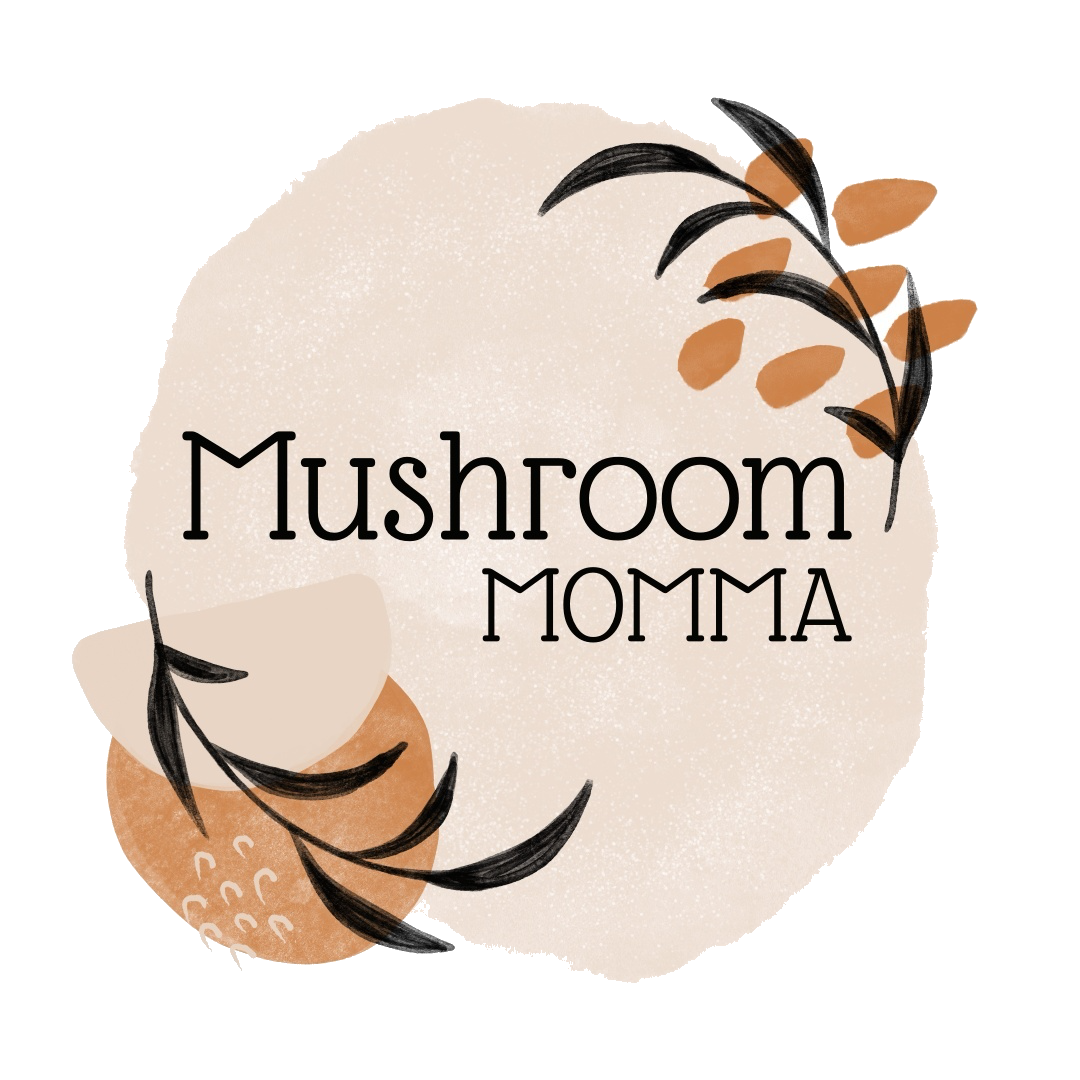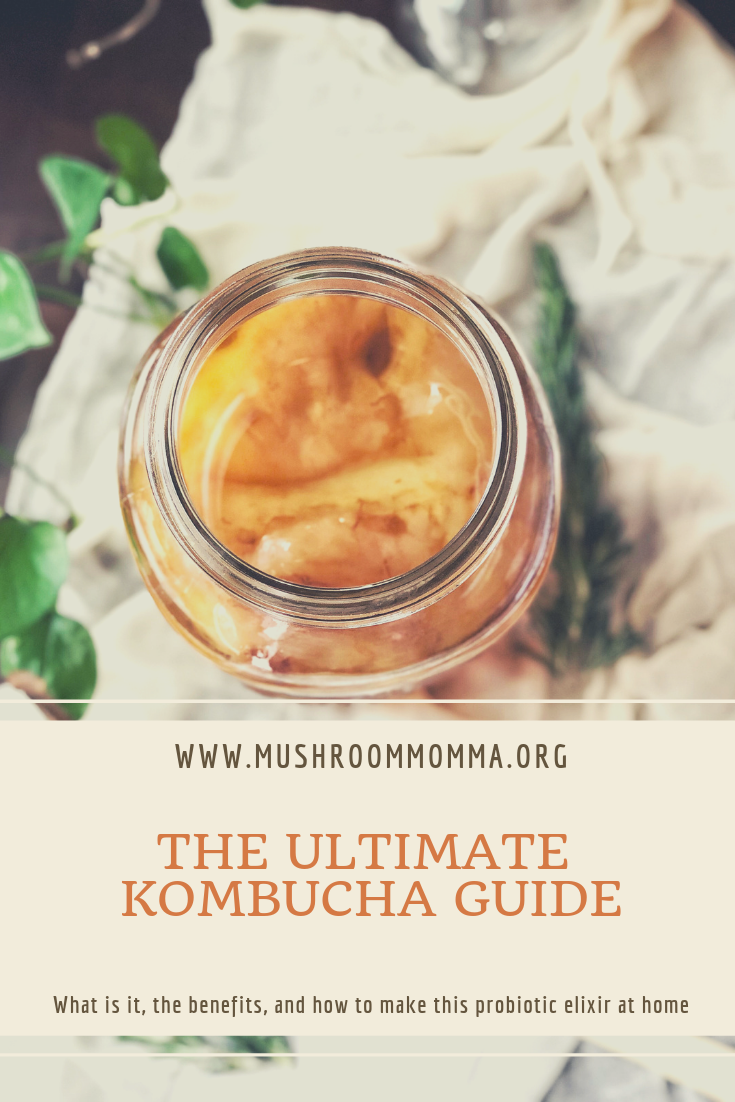The Ultimate Kombucha Guide

This post may contain some affiliate links. For more information, visit my disclosure page.
Kombucha. A strange, living, bubbly probiotic drink. What is it and where did it come from?
Kombucha’s history is a bit unknown. It is said kombucha began in China over 2,000 years ago. It was known as the “Remedy for Immortality” and it has also been called “Elixir of Long Life” and “Magic Juice.” It was later brought to Japan by Dr. Kombu to treat the Japanese emperor, Inkyo, for digestive problems.
It likely traveled down the Silk Road and found its way to Russia in the 19th century where scientific records of kombucha began to appear. There it was known as “Tea Mushroom”. Rudolf Sklenar of Germany, brought the culture to Germany after witnessing it being used to help injured soldiers. It was used in a specific protocol to heal cancer patients, and hundreds of studies were conducted in Russia and Germany from 1920’s -30’s, with most focus on improvements in digestion and diabetes. Kombucha was very popular until WW2, when sugar was rationed making it hard to come by. It had another boost in popularity in the 1960’s when Swiss research confirmed the health benefits of drinking kombucha. It wasn't until the 1990’s that kombucha made its way into stores, before that it was passed around like chain mail and could only be brewed at home.
So, What is it?
Kombucha begins life as a sweet tea and is fermented with a SCOBY, which consumes the sugar in the tea to create the fizzy, probiotic drink. A SCOBY (symbiotic culture of bacteria yeast) is the result of the fermentation process, also known as the pellicle. The living culture within the tea that allows fermentation to happen is known as The Mother. A well nourished Mother can live indefinitely.
The resulting fermented tea contains a range of lactobacillus and acetobacter bacteria, yeast, and other vitamins and enzymes. These include vitamin C, B1, B2, B3, B5, B12, various acids and antioxidants. These provide the body with energy and help it process fats and proteins which are vital for the nervous system.
SCOBY- symbiotic culture of bacteria yeast. The byproduct of the fermentation process.
Why Should I Drink It?
Kombucha, among many fermented foods, has many health benefits. Some anecdotal benefits include:
Substitute for soda
Hunger control
Better digestion and regulates bowel movements.
Supports acid reflex
Nourishing for skin and hair
Boosts immunity and fights off pathogens
Anti-microbial, anti-bacterial, and anti-fungal
Relieves headaches and is a good hangover cure.
Energy booster (especially when brewed with black tea)
Reduces stress
Supports the body and brings it back to balance
Although it is an acidic drink, it is alkaline on the body.
Safe for those with diabetes and candida because the sugars are converted to acids during fermentation
Kombucha’s culture also has detoxifying agents. These neutralize and remove toxins such as pesticides, plastics, resins, and herbicides and eliminates them through the kidneys.
Kombucha is also effective in reducing arthritis and joint pain due to replenishing cartilage and joint fluid from a byproduct of glucuronic acid from the kombucha culture.
Being a fermented beverage, kombucha has a myriad of benefits to healing the gut, and thus healing the whole body. To learn more about the gut, and why you should care about it’s health, click here.
How To Make Kombucha
Makes about 1 gallon
INGREDIENTS
1 Gallon of Water
1 cup sugar (regular granulated sugar works best)
6-8 bags black tea, green tea, or a mix (or 2 -3 tablespoons loose tea)
2 cups starter tea from last batch of kombucha or store-bought kombucha (unpasteurized, neutral-flavored)
1 SCOBY
EQUIPMENT
Tightly woven cloth (like clean napkins or tea towels), coffee filters, or paper towels, to cover the jar
INSTRUCTIONS
Note: Avoid prolonged contact between the kombucha and metal both during and after brewing. This can affect the flavor of your kombucha and weaken the scoby over time.
Kombucha has two phases: F1 and F2. F1 is known as the first ferment. It is sweet tea, starter, and SCOBY and produces an unflavored, tangy brew with slight carbonation. F2 is optional, and is known as the second ferment. F2 includes bottling, flavoring, and producing more carbonation.
F1:
Make the tea concentrate: Bring 4 cups of water to a boil. Remove from heat and stir in the sugar to dissolve. Drop in the tea and allow it to steep 10-20 minutes. Strain tea concentrate into a gallon jar and add the rest of the body.
Add the starter tea and SCOBY: Once the tea is cool (under 95 degrees) stir in the starter tea. Be sure to not add starter to hot tea. (The starter tea makes the liquid acidic, which prevents unfriendly bacteria from taking up residence in the first few days of fermentation.) Gently slide the scoby into the jar with clean hands. Cover the mouth of the jar with a few layers tightly-woven cloth, coffee filter, or paper towel secured with a rubber band.
Ferment for 7 to 14 days: Keep the jar at room temperature, out of direct sunlight, and where it won't get jostled. Ferment for 7 to 14 days, checking the kombucha and the scoby periodically.
It's not unusual for the scoby to float at the top, bottom, or even sideways during fermentation. A new cream-colored layer of scoby should start forming on the surface of the kombucha within a few days. It usually attaches to the old scoby, but it's ok if they separate. You may also see brown stringy bits floating beneath the scoby, sediment collecting at the bottom, and bubbles collecting around the scoby. This is all normal and signs of healthy fermentation.
After 7 days, begin tasting the kombucha daily by pouring a little out of the jar and into a cup or using a stainless steel straw. When it reaches a balance of sweetness and tartness that is pleasant to you, the kombucha is ready to bottle.
Remove the scoby and set aside 2 cups of starter for the next batch.F2 (optional): Process of adding to bottles, adding more sugar (fruit) and seal up to produce carbonation. The fruit gives yeast more sugar to eat and convert into carbondioxide. Since its sealed, carbon dioxide gets trapped in the liquid and makes it bubbly. Bottle the finished kombucha: Pour the fermented kombucha (straining, if desired) into bottles using the small funnel, (or use a pitcher) along with any juice, herbs, or fruit you may want to use as flavoring. If wanting to add a non sweet flavor such as herbs or fragrant teas, bottle when the brew is still on the sweet side, to ensure theres enough sugar for the yeast. Add up to 1/4 of the bottle with fruit, juice, or desired flavoring, fruit can be cut in chunks or pureed, pureed fruit allows the yeast to access the sugars better however, which allows for more fizz. Leave about a half inch of head room in each bottle. Dry the tops of the bottles completely before capping. Use a rubber gripper to tighten to no air escapes.Carbonate and refrigerate the finished kombucha: Store the bottled kombucha at room temperature out of direct sunlight and allow 1 to 3 days for the kombucha to carbonate. It’s a good idea to put them in a box to prevent a mess incase one explodes. Refrigerate after 1-3 days to stop fermentation and carbonation.
Make a fresh batch of kombucha: Combine the starter tea from your last batch of kombucha with the fresh batch of sugary tea, and pour it into the fermentation jar. Slide the scoby on top, cover, and ferment for 7 to 14 days.F3 (optional):Doing an F3 can improve carbonation and add more complexity to your kombucha. F3 entails straining out the fruit, and allowing the bottled brew to ferment 1 more day. It is not necessary, only a preference for some. If F2 produces a lot of carbonation but you want to strain out the fruit, chill before opening to prevent fizzing over.
Kombucha during F2, or second ferment.
NOTES
SCOBY: It is normal for the scoby to float on the top, bottom, or sideways in the jar. It is also normal for brown strings to form below the scoby or to collect on the bottom. If your scoby develops a hole, bumps, dried patches, darker brown patches, or clear jelly-like patches, it is still fine to use. Usually these are all indicative of changes in the environment of your kitchen and not a problem with the scoby itself. A new SCOBY will form with every new brew. You can keep them in the same brew, the more SCOBYS the faster the tea will ferment.
Covering for the jar: Cheesecloth is not ideal because it's easy for small insects, like fruit flies, to wiggle through the layers. Use a tightly woven cloth (like clean napkins or tea towels), coffee filters, or paper towels, to cover the jar, and secure it tightly with rubber bands or twine.
Putting Kombucha on Pause: If you'll be away for 3 weeks or less, just make a fresh batch and leave it on your counter. It will likely be too vinegary to drink by the time you get back, but the scoby will be fine and the tea will make a strong starter. For longer breaks, store the scoby in a fresh batch of the tea base with starter tea in the fridge or in a “hotel”.
SCOBY hotel: A SCOBY hotel is a vessel used to house extra accumulated scouts and starter tea. This allows for back-up tea and scobys, and also allows for a break from brewing. You can place a lid on the jar and store in the fridge, or keep it out and just feed a bit of sweet tea every few weeks.
Other Tea Options: Black tea has the most tannins, creating a more robust flavor and is the most reliable. Other teas can be used too. Green tea, white tea, oolong tea, or puh-er. Other flavors can be experimented with but use an extra scoby. These include herbal teas, rooibos, or even coffee (Koffucha). Avoid any teas that contain oils, like earl grey or flavored teas.
Alcohol Content: It could contain .5%-2.5% alcohol depending how it was made and for how long it fermented. If bottled while sweet, it could become more alcoholic. The caffeine amount is reduced but is still slight, as are the sugars. When brewed too long it can become vinegar and used as a tonic.
It is potent. Best to start with a cup a day. Home brew is stronger as far as the bacteria in it because it is not pasteurized.
Bottle Options: Bottles should be pressure rated. These can be purchased from a brew supply store. Swing top, stout, and boston rounds are common bottles. Capped bottles should have a rubber insert for a better seal. Avoid decorative bottles, they are more likely to explode.
Avoid the use of Vinegar: There are some methods that call for vinegar. Vinegar can cause vinegar eels and should not be used with kombucha.
Avoid Prolonged Contact with Metal: Using metal utensils is generally fine, but avoid fermenting or bottling the kombucha in anything that brings them into contact with metal. Metals, especially reactive metals like aluminum, can give the kombucha a metallic flavor and weaken the scoby over time.
Burping the Bottles: Burping can ensure the bottles do not explode, but it can also flatten the kombucha. Only burp when necessary, and only burp once the brew has cooled. Burping while it is at room temp can make a fizzy mess, so only open bottles when kombucha is chilled.
Mold: Mold will usually happen during F1. It looks like mold found on cheese, bread, etc- will be fuzzy, and on the surface, and floating. Typically shaped in circles. Avoid mold by leaving alone the brew (do not mess with it) and using enough starter tea so the pH will drop low enough to make the brew inhospitable for pathogens. Do not refrigerate brew as the yeast becomes dormant, allowing mold to grow. (under 65 degrees) Spots, opaque and clear circles floating, or stringy dark brown pieces are all normal. Mold is rare, but if it happens, toss the whole brew and start over.
Cleaning: For the brew vessel, you can just put the new brew in, no need to clean. To clean the bottle- use boiling water. If using soap, be sure it is antibacterial. Rinse bottles with a little kombucha.
A small SCOBY may grow in the bottles of finished kombucha. These are edible, you can eat them or throw them out. They shouldn’t be used to make another brew though since they have been in flavorings. You may also see sediment at the bottom of your finished brews from the yeast. This is also very normal.
TROUBLESHOOTING
Kombucha will start off with a neutral aroma and then smell progressively more vinegary as brewing progresses. If it starts to smell cheesy, rotten, or otherwise unpleasant, this is a sign that something has gone wrong. If you see no signs of mold on the scoby, discard the liquid and begin again with fresh tea. If you do see signs of mold, discard both the scoby and the liquid and begin again with new ingredients.
A scoby will last a very long time, but it's not indestructible. If the scoby becomes black, that is a sign that it has passed its lifespan. If it develops green or black mold, it is has become infected. In both of these cases, throw away the scoby and begin again.
To prolong the life and maintain the health of your scoby, stick to the ratio of sugar, tea, starter tea, and water outlined in the recipe. You should also peel off the bottom (oldest) layer every few batches. This can be discarded, composted, used to start a new batch of kombucha, or given to a friend to start their own. Scobys can also be used to make yogurt, dehydrated for leather strips, used to make soap, the possibilities are endless!
Resources
Ferment By Holly Davis
The Big Book of Kombucha By Crum and LaGory
www.kombuchakamp.com










